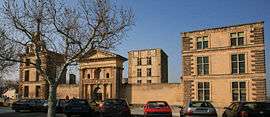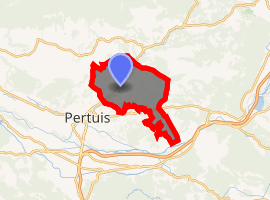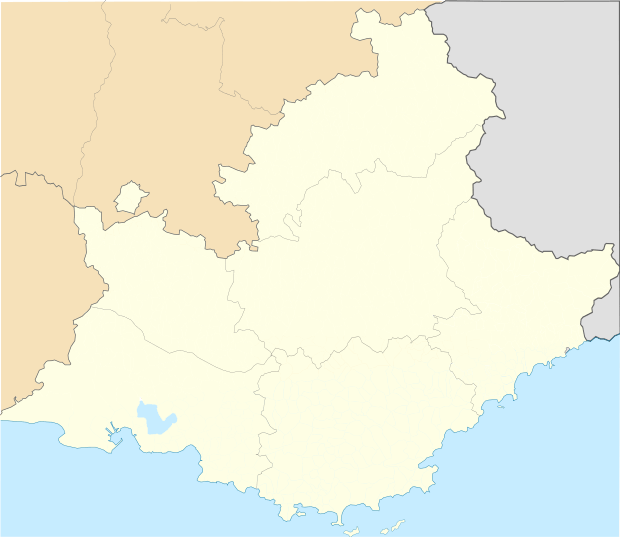La Tour-d'Aigues
La Tour-d'Aigues is a commune in the Vaucluse department in the Provence-Alpes-Côte d'Azur region in southeastern France.
La Tour-d'Aigues | |
|---|---|
 Castle of La Tour-d'Aigues | |
 Coat of arms | |
Location of La Tour-d'Aigues 
| |
 La Tour-d'Aigues  La Tour-d'Aigues | |
| Coordinates: 43°43′34″N 5°32′55″E | |
| Country | France |
| Region | Provence-Alpes-Côte d'Azur |
| Department | Vaucluse |
| Arrondissement | Apt |
| Canton | Pertuis |
| Government | |
| • Mayor (2008–2014) | Jean-François Lovisolo |
| Area 1 | 41.3 km2 (15.9 sq mi) |
| Population (2017-01-01)[1] | 4,287 |
| • Density | 100/km2 (270/sq mi) |
| Time zone | UTC+01:00 (CET) |
| • Summer (DST) | UTC+02:00 (CEST) |
| INSEE/Postal code | 84133 /84240 |
| Elevation | 220–510 m (720–1,670 ft) (avg. 270 m or 890 ft) |
| 1 French Land Register data, which excludes lakes, ponds, glaciers > 1 km2 (0.386 sq mi or 247 acres) and river estuaries. | |
Geography
The town is located at the south of the Grand Luberon, 5 km away from Pertuis. It is the capital town of the Pays d'Aigues.
Climate
La Tour d'Aigues is under the influence of the mediterranean climate characterised by hot and dry summers and mild winters.
History
Middle Ages
The town belonged to the counts of Forcalquier until the end of the 12th century, when it passed to the Sabran family through marriage, and later to the Agoults.
La Tour d'Aigues was partly destroyed in 1390 when facing the assault of Raymond VIII de Turenne. In addition to this, epidemics emptied the town of its population. This crisis allowed Fouquet d'Agoult to acquire new territories: le Tourel, la Bastidonne, Saint-Martin-de-la-Brasque and Cabrière d'Aigues.[2]
The Templars also had an establishment at La Tour d'Aigues.[3]
Renaissance
Raymond d'Agoult, Fouquet d'Agoult's son, died without an heir in 1505. His sister Jeanne, wife of Antoine de Bolliers, viscount of Reillane, inherited La Tour d'Aigues. They brought farmers from their lands in Piémont to enrich the land. The town then passed on to the d'Agoult de Sault in 1584. It then belonged to the Lesdiguières, to a certain Villeroy in 1617, and, finally, to the Brunys in 1719 who were unpopular rich merchants from Marseille.[4]
La Tour d'Aigues faced a devastating plague in 1630 and 1631.[5]
Early Modern Period
When the Villeroys went bankrupt, they were forced to sell the Renaissance castle built by Nicolas de Bolliers in 1550[6] to Jean-Baptiste Bruny. His son, Jérôme Bruny, turned the castle into a museum.
Culture
Museums and sights
- Parc naturel régional du Luberon
- The Renaissance castle, entirely renovated in the 16th and 17th century. It burnt down before the French Revolution. Catherine de Médicis is said to have visited it in 1579.
- The Eglise Notre-Dame de Romégas which dates back to the 13th century.
- The Maison d'Estienne du Bourguet built from 1658 to 1671 with 17th-century murals.
- The Museum of earthenware in the cellars of the castle.
Notable People
See also
- Côtes du Luberon AOC
- Communes of the Vaucluse department
- Luberon
References
- "Populations légales 2017". INSEE. Retrieved 6 January 2020.
- Ollivier-Elliot, Patrick (2008). Luberon, Pays d'Aigues. Edisud. p. 195. ISBN 978-2-7449-0764-7.
- Clébert, Jean-Paul (1991). La Durance. Privat. p. 73. ISBN 2-7089-9503-0.
- Ollivier-Elliot, Patrick (2008). Luberon, Pays d'Aigues. Edisud. p. 194. ISBN 978-2-7449-0764-7.
- Bailly, Robert (1986). Dictionnaire des communes du Vaucluse. A. Barthélémy. p. 424. ISBN 2-903044-27-9.
- Bailly, Robert (1986). Dictionnaire des communes du Vaucluse. A. Barthélémy. p. 425. ISBN 2-903044-27-9.
| Wikimedia Commons has media related to La Tour-d'Aigues. |